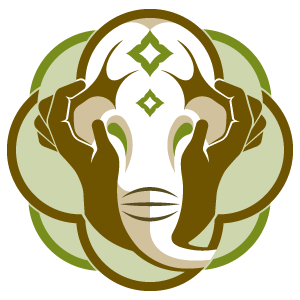The veterinary team with the Chiang Mai University Mobile Vet Clinic continued their mission to care for Thai elephants of the surrounding areas. The team worked through multiple cases of wounds or injuries, gastrointestinal upset, and at one camp they did health checks for 11 elephants. They conducted another EEHV awareness educational meeting for mahouts and owners and, happily, the team was able to celebrate the successful treatment of an EEHV-4 case.
A male elephant residing in Hang Dong suddenly developed swelling and stiffness in his left forelimb. During the history-taking, the mahout was unsure of the cause of the injury. The camp’s veterinarian initially administered a course of non-steroidal anti-inflammatory drugs (NSAIDs) for four consecutive days and then contacted the CMU team to request laser therapy.
Bull presenting his swollen left foreleg
Upon examination, the left forelimb showed significant swelling extending from the elbow joint down to the foot. The affected muscles and tendons were tender upon palpation. The elephant was not laying down to rest at night, though his appetite and defecation remained normal. A thermoscan camera was used to assess the area, and the highest temperature — indicating inflammation — was localized at the elbow joint. Laser therapy was applied along the affected leg using settings for anti-inflammatory and anti-swelling effects. After treatment and consultation both the camp and CMU veterinary teams agreed that supportive care should continue, and the mahout was advised to perform regular cold compresses to help reduce swelling. Laser therapy was scheduled for at least twice per week. Encouragingly, the mahout reported visible improvement the day after the first session, the elephant began flexing the joint more easily during walking. After four laser therapy sessions over the course of a week, the elephant’s swelling and tenderness had subsided significantly.
The thermoscan showing inflammation on the left elbow
Following the successful EEHV awareness session in April, the staff of the Chiang Mai University Mobile Vet Clinic continued efforts to engage more elephant camps in the Mae Wang District. Several camps and mahouts expressed appreciation for the initiative and acknowledged the importance of understanding EEHV, especially its early signs and the urgency of reporting suspected cases.
During the sessions, real case examples were shared and participants discussed practical steps for monitoring young elephants including daily health checks, recognizing abnormal symptoms, and maintaining clear communication with veterinarians. Interactive discussions allowed staff to ask questions and share their own experiences, helping to create a more collaborative and informed environment. The goal is to ensure that all camps—regardless of size or resources—are equipped with the basic knowledge and confidence to act quickly and effectively if a suspected EEHV case arises. By building this awareness and collaboration, the CMU Mobile Clinic vets hope to improve outcomes and protect the next generation of Thai elephants.
Participants share and discuss on their experience with EEHV
Near the end of the month, the team was called for a 7-year-old juvenile male elephant experiencing abdominal discomfort, leading him to consume soil instinctively as a form of natural deworming. However, given the presence of intestinal parasites and the possibility of gastrointestinal infection, the vet proceeded with further diagnostics. Blood samples were collected for hematology, and supportive treatments were given, including a painkiller, anti-flatulent, antiparasitic drug, and activated charcoal. Vitamin C and antiviral drugs were also prepared in case they became necessary.
The hematology results came back within normal ranges. However, due to persistent concerns, the blood was submitted for EEHV testing. Surprisingly, a weak positive for EEHV type 4 was detected. Given this result, the veterinarian immediately instructed the mahout to begin antiviral treatment. The following day, the mahout reported improvement in the elephant’s appetite and general demeanor. The elephant accepted the medications well. A follow-up visit was conducted on the next day to monitor clinical signs and collect another blood sample. The second PCR test continued to show a less EEHV-4 positive, though the elephant remained clinically normal. The antiviral regimen was continued, and within one week, the elephant showed full clinical recovery. The final blood sample returned negative for EEHV, at which point treatment was discontinued. This case highlights the importance of vigilant monitoring and early intervention, even in cases that initially appear to be mild colic, especially in young elephants at risk of EEHV.
Mahout medicating EEHV positive young bull
We are so grateful for the continuing efforts of the Chiang Mai University Mobile Vet Clinic Team! Help AES continue to support them as they strive to make a better future for Thai elephants, by donating TODAY at www.asianelephantsupport.org/donate






